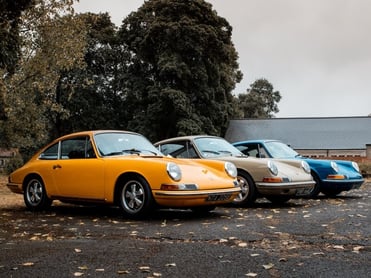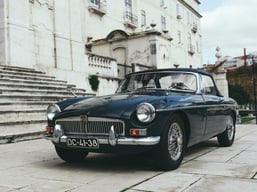The automotive industry is changing by the minute. New technologies are making cars much safer and more environmentally friendly. Gas-powered versions harm the environment, leading many to switch to electric vehicles.
What does this mean for your classic cars? Chevrolet isn’t turning the 1961 Corvette into an EV anytime soon — you’ll have to modify the vehicle yourself. Converting older vehicles to EVs is a growing industry.
Here’s what to expect in this market for 2024 and beyond.
Reaching New Heights
Classic car owners use conversion kits to change their vehicles into EVs. Experts gave this market a $500 million valuation in 2021. It hasn’t reached $1 billion yet — but it won’t take long. Research shows the EV conversion kit market has a 16.5% compound annual growth rate (CAGR), meaning it will reach about $2.6 billion by 2031.
The CAGR for EV conversion kits is on par with the cars themselves. Data show the worldwide market for EVs has a 17.02% CAGR, reaching a market value of over $858 billion by 2027. The EV conversion kit market will grow as EV enthusiasm rises for classic car collectors and the general public.
Going Mainstream
One factor that will help EV classic car conversions is showing the process in mainstream media. More people hearing about it allows EV conversion to grow in popularity. HBO Max will air a new series featuring Robert Downey Jr. and classic car conversions this summer.
Downey Jr. takes a lighthearted view of converting classic cars to EVs in the show. It won’t be very technical — the show is more for laughs. Some vehicles will include the 1970 Plymouth Satellite restored with Tesla battery packs.
You’ll see the essential classic cars like a C2 Chevy Corvette and a Camaro convertible. However, there will also be interesting rebuilds like the Volkswagen Microbus — a superb vehicle for going on EV road trips. Shows like “Downey’s Dream Cars” will elevate EV classic car conversion to mainstream audiences.
Higher EV Enthusiasm
You can already see higher EV enthusiasm in the classic car world. Collectors are warming up to conversion as technology develops. You may miss the carburetor and fuel injector, but the world is headed toward more environmentally friendly options. Plus, these cars are easier to maintain because they have fewer parts.
For example, look at the Specialty Equipment Market Association (SEMA) show in late 2022. SEMA dedicated over 21,000 square feet to EVs — a significant increase compared to the 2,500 square feet in 2021.
More EVs at trade shows will push the automotive industry toward electrification, even for classic cars. Some may raise their eyebrows at electrifying their Ford Mustang, but it’s where the industry is going. EVs will be a significant part of SEMA and other trade shows in 2024 and beyond.
More EV Chargers
It’s no secret EVs are becoming more popular nationwide. The increased demand has led to an increase in EV charging stations. Battery-electric vehicles are becoming so popular that the U.S. government is expanding the charging infrastructure.
Currently, the United States has about 130,000 public chargers. The federal government has pledged to build more than 500,000 chargers this decade.
Increasing the number of public chargers makes it easier for car owners who live in rural areas. They’ll be more likely to drive classic Mercury Cougars around town if they can recharge them at public chargers.
Supply Chain Improvement
The past three years have seen chaos in the automotive industry. A pandemic with supply chain disruptions coupled to slow things down for EV progression. The low supply and high demand have created high prices and discouraged classic car owners from converting. However, the supply chain outlook is more optimistic for 2024 and the rest of the decade.
Despite the supply chain issues, Chevrolet is moving forward with its crate EV conversion kit with an eCrate motor. The manufacturer hasn’t released it yet — but you can expect it in the next couple of years as supply chain woes dwindle. The kits will make it much easier for classic Corvette and Camaro owners to convert their cars at home instead of spending six figures to pay a specialist.
Smaller Batteries
One problem classic car owners encounter is battery size. Your vehicle may have limited space where the motor goes because it has a small engine. Finding a fitting battery is challenging and could discourage EV conversion. However, this problem could wane in the future thanks to innovative technology.
EV batteries are becoming smaller. Modern lithium-ion batteries have about 40 kilowatt-hours (kWh), but some can reach 100 kWhs. In 2024 and beyond, you’ll see smaller batteries that are just as efficient as the current ones.
For example, look at solid-state batteries. These devices use solid materials instead of lithium to power the car. Removing lithium also makes the vehicle less flammable. The technology isn’t here yet — but automakers like Volkswagen aim for 2024 or 2025 to use solid-state batteries for their machines. Introducing them to the market would significantly improve battery performance and encourage more classic car owners to make the electric switch.
Retooling the Past for a Brighter Future
Many classic cars sit in garages because they can’t run anymore. What if you replaced the current engine with a battery and made it an EV? That’s what many owners nationwide have started to do.
The EV classic car conversion movement is here and will grow this decade. TV shows, improving supply chains and innovative technology will carry the industry into the future.

Comments